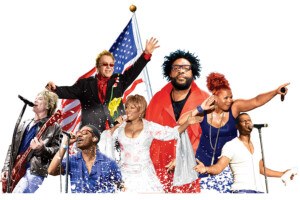Horseshoe Crabs Are About to Have an Orgy on Delaware Bay Beaches. Here’s Why — and What’s Threatening It
It’s a breathtaking wildlife bacchanal that only happens here, and some pretty major forces (climate change, Big Pharma) are conspiring against it. Can science save this symbiotic spectacle?
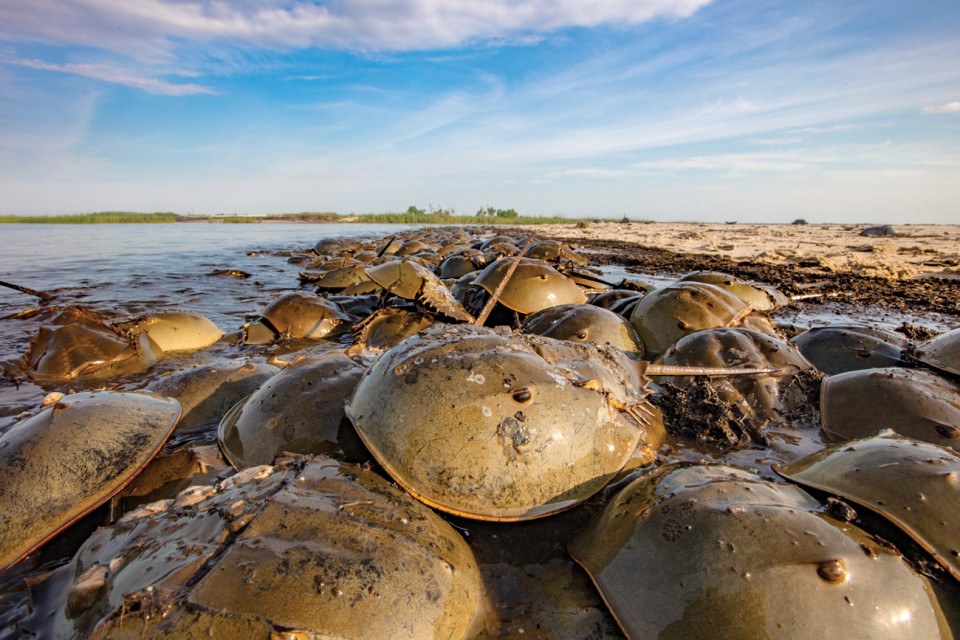
Horseshoe crabs piled up on New Jersey’s Fortescue Beach / Photograph by Doug Wechsler
When the tide comes under May’s full moon, an extraordinary, almost magical event occurs on Delaware Bay beaches: Like an invasion of small prehistoric tanks, millions of horseshoe crabs rumble into the surf, larger females often hauling multiple male suitors, the latter desperately clamped onto the edges of the females’ shells.
Along the tideline, the crabs will lay billions of eggs, little green BBs roiling in the surf. Each female is capable of laying 4,000 eggs daily, and over the next few weeks, she’ll return multiple times at high tides, her visits producing as many as 80,000 eggs. Horseshoe crabs are living fossils: Their lineage dates back 450 million years — they’re twice as old as the first dinosaurs — and have remained relatively unchanged this whole time.
Then, the plot thickens. With exquisite timing, thousands of exhausted, famished red knots — robin-sized sandpipers with brick-red chests — alight on these same beaches in the midst of a remarkable 9,500-mile migration, traveling from winter in South America’s Tierra del Fuego to springtime nesting sites above the Arctic Circle. In a marriage of two continents, knots are flying from the bottom of the world to its very top.
Desperately craving nourishment to survive the final 2,000 miles of this epic journey, the birds stuff themselves silly on the fat-rich eggs that provide life-saving energy. Having adapted to gobbling thousands of these nourishing BBs a day, they’ll double their weight in only two weeks. The knots aren’t alone, as other starving migrants — sandpipers, plovers, ruddy turnstones — join the frenzy, competing with hundreds of local gulls as well. The cacophony is crazed, like Times Square on New Year’s Eve.
One ornithologist back in the ’80s dubbed this annual event “sex and gluttony on the Delaware Bay.” It’s a must-see phenomenon — one of the world’s longest-distance migrators feeding off one of its oldest living fossils. And while knots and crabs meet on other East Coast beaches, the Delaware Bay is home to the world’s largest concentration of horseshoe crabs and one of its largest gatherings of knots.
In recent decades, though, a number of threats have conspired to imperil both bird and crab. When a life-saving discovery about the crabs’ blood made them invaluable and the crabs were being harvested in earnest, there was suddenly less sex on May beaches. And with fewer eggs, there was far less gluttony. Both species became caught in a tug of war between competing forces. Today, the synchrony of crab and knot is one of the region’s most important conservation stories. While many people are engaged in the race to save both, there’s a real danger we’ll lose a wildly distinctive marvel.
True Bluebloods
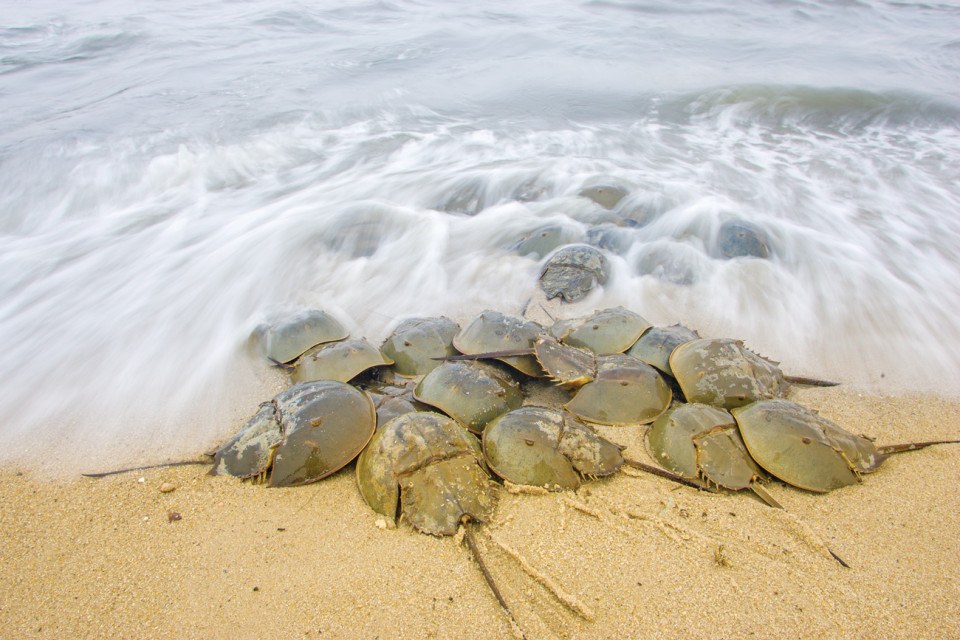
Horseshoe crabs on Moores Beach / Photograph by Doug Wechsler
Horseshoe crabs aren’t really crabs at all, but closer in kinship to scorpions and spiders. And while they’re scary to some folks (and kids), they’re surprisingly cool. A jawless mouth is located on the underside of the shell at the confluence of 10 legs, so leg bristles can push worms and small critters into it. The shell sports 10 eyes of various sizes that mostly see light and shadow — great for sensing moonlight and thus the higher tides that full moons bring. Their spiny tails, which aren’t harmful or poisonous, are used to right themselves after they’ve been flipped by waves. Larger females need almost a full decade, or even more, before they can produce that massive number of eggs — a surprisingly long development schedule for an invertebrate.
Uncountable, unthinkable numbers of the crabs once came ashore to breed. In the 1800s, piles of crabs along beaches reached shoulder height, recounts Tim Dillingham, executive director of the shoreline conservation group American Littoral Society. Their eggs formed windrows along the beach. “It was a superabundance of life — enough eggs to sustain crab populations, but also more than enough for shorebirds,” Dillingham says.
We soon found a use for that superabundance. The crab bodies were ground into cheap fertilizer, earning the critters the local nickname “king crab” — not to be confused with the Alaska king crab we greedily devour at Red Lobster. South Jersey’s King Crab Landing and Delaware’s Slaughter Beach are reminders of this era. By the early 20th century, crab populations were slammed by this overharvest; luckily, modern fertilizers were concocted in the ’70s, and crab harvesting stopped. Nowadays, few locals even remember where King Crab Landing used to be.
But then fishermen found the crabs were useful in bait traps to attract more valuable eels and whelks — the latter sold as conch — and crabs were again under pressure. Soon thereafter, an even more important discovery was made. A copper atom at the center of the crabs’ blood molecules colors their blood blue, and this blue blood is loaded with cells — amoebocytes — that attack the waste products of decaying bacteria. Because these cells clot around toxins in blood, scientists learned in the ’50s that crab blood could quickly test the purity of drugs and medical devices far better, more cheaply and more effectively than the rabbit pyrogen tests then used. In 1977, the FDA formally approved the use of this compound, Limulus amebocyte lysate, or LAL. (That first word is simply the crab’s scientific genus.) Today, the FDA requires that all drugs and vaccines, plus scalpels, syringes, IV lines, stents, artificial joints and more, be LAL-tested to ensure their safety before use. LAL has saved millions of lives, and each of us has benefited from horseshoe crabs — many of us more than once during the pandemic alone.
In the wake of the LAL discovery, the market value of horseshoe crabs skyrocketed. Author Scott Weidensaul, a writer of many books on birds and migration, remembers his first visit to Delaware Bay, in the late ’80s. “It was astonishing,” he says. “The beach was carpeted with horseshoe crabs like cobblestones, and there were enormous flocks of shorebirds. But over several years, I became aware that there was more and more harvesting — you’d see trucks pulling away with crabs piled high.”
The gold rush came in the ’90s, according to the American Littoral Society’s Dillingham, with fishermen catching crabs for bait while trucks hauled them away for LAL. “We decimated the population,” he says. “Some 75 percent of the crabs were taken.”
As crab numbers collapsed, these practices became regulated; New Jersey’s legislature passed a 2008 ban on crab harvesting for bait. Delaware tried to ban the catch, too, but was sued and lost. While the Atlantic States Marine Fisheries Commission, or ASMFC — the agency that regulates horseshoe crabs — still allows limited bait fishing in the bay, females are protected. In 2024, ASMFC will permit 500,000 crabs — males only — to be caught for bait. That harvest number has steadily ticked downward; according to the ASMFC, quotas were implemented that brought the harvest down from 2.75 million in 1998 to 1.05 million by 2003.
But biomedical capture, even of females, lies outside these regulations and is allowed by both states, and LAL harvesting is a multimillion-dollar industry. In 2022, ASMFC reported that nearly a million bay horseshoe crabs were harvested annually to be bled, with the larger females more valuable because they contain more blood. At bleeding facilities, crabs are mounted onto racks that bend them in half to stretch out a thin membrane into which a syringe is inserted, and about a third of each crab’s blood — a coffee cup’s worth — is withdrawn.
A spokesperson for Charles River Laboratories, a biomedical company with a local presence in Wayne and Malvern, reports that crabs are “hand-harvested” by permitted fishermen and says, “Our skilled technicians extract a limited amount of blood before fishermen promptly return them to coastal waters. We take significant precautions to limit the stress on the crabs.”
Still, the process does affect them. While the industry claims only three to five percent die from the bleeding, ASMFC puts the number at 15 percent, and independent university research and crab advocates claim the number is far higher — 30 percent or more. That’s a big disparity. And then there are the sub-lethal impacts: Does the stress affect the crabs’ longevity and breeding success?
Any harm to longevity or breeding could have cascading effects: Since crabs and knots are intimately connected, that ’90s gold rush slammed the knots.
The Unraveling of the Red Knot
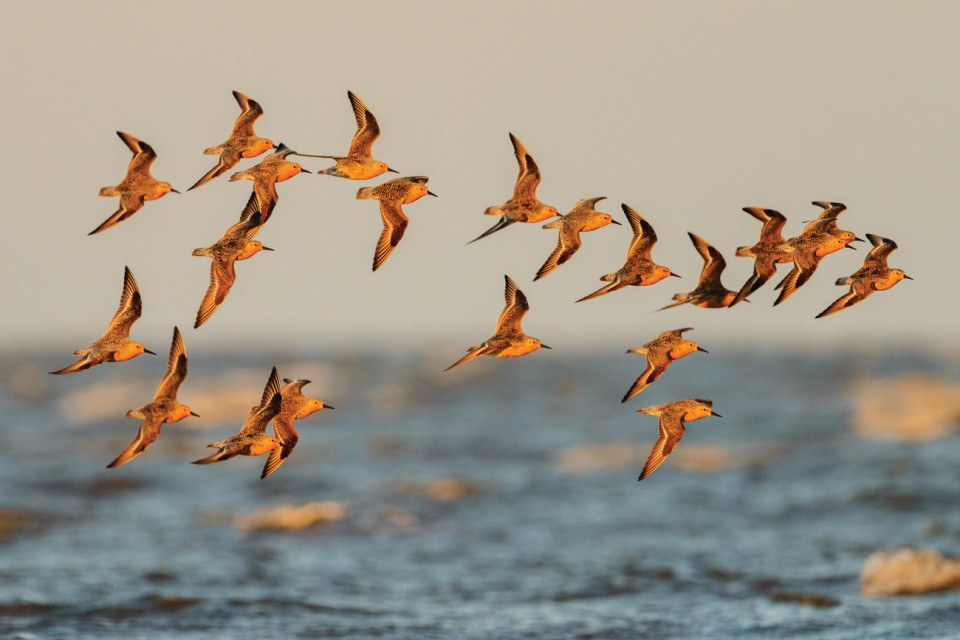
Red knots on Fortescue Beach / Photograph by Christian Hunold
The red knot overwinters in the mud flats of Tierra del Fuego, at the very bottom of South America. When the mating urge becomes irresistible, knots bulk up on small mussels and clams and launch themselves into the air to start the journey north. They refuel along coastal Brazil, then fly nonstop for five or six days over the Atlantic, landing on Delaware Bay beaches starving, their bodies having digested muscle and bone to provide nourishment during the trip.
They’ll stay here for two weeks, hoovering. “The Delaware Bay is the gas station where knots go to fill up their tank,” says David Mizrahi, of New Jersey Audubon. In June, their fat reserves replenished, they’ll fly to the Canadian Arctic to nest and lay eggs.
The distances knots travel are stunning — 19,000 miles annually. While most live maybe seven years, 15-year-old knots have been documented, and one tagged knot dubbed “Moonbird” lived a remarkable 19 years. That’s 361,000 miles in one lifetime — the equivalent of a trip to the moon and halfway back. It’s a brilliant evolutionary strategy: Knots arrive in the Arctic just as spring brings an explosion of insect life, perfectly timed for hatchling knots to devour. And the birds all return to Patagonia at the beginning of that hemisphere’s summer. While the knot inhabits two of the world’s coldest, harshest places, it dwells in perpetual summertime.
Our knot is one of six subspecies globally, each one flying great lengths to breed in different portions of the Arctic Circle. Ours is named rufa, after the Latin word for “red.” This month, an astounding 80 to 90 percent of the world’s rufa red knots are dining along Delaware Bay.
If the bay is a gas station, crab eggs are the gas, and red knots depend on massive numbers of eggs. As crab harvesting ramped up in the ’90s and ’00s, the density of crab eggs dwindled, and knot populations crashed. Larry Niles, an independent biologist who’s been monitoring knots for decades, reports there were 93,000 red knots on the Delaware Bay in 1986, and consistently more than 80,000 into the ’90s. By the turn of the millennium, that number was down to 30,000. Last year’s survey found 22,000 — a 75 percent decline in migrating knots since 1986. Equally troubling, Niles’s studies show only half of the bay’s knots now gain enough weight to complete the life cycle. There just aren’t enough crab eggs.
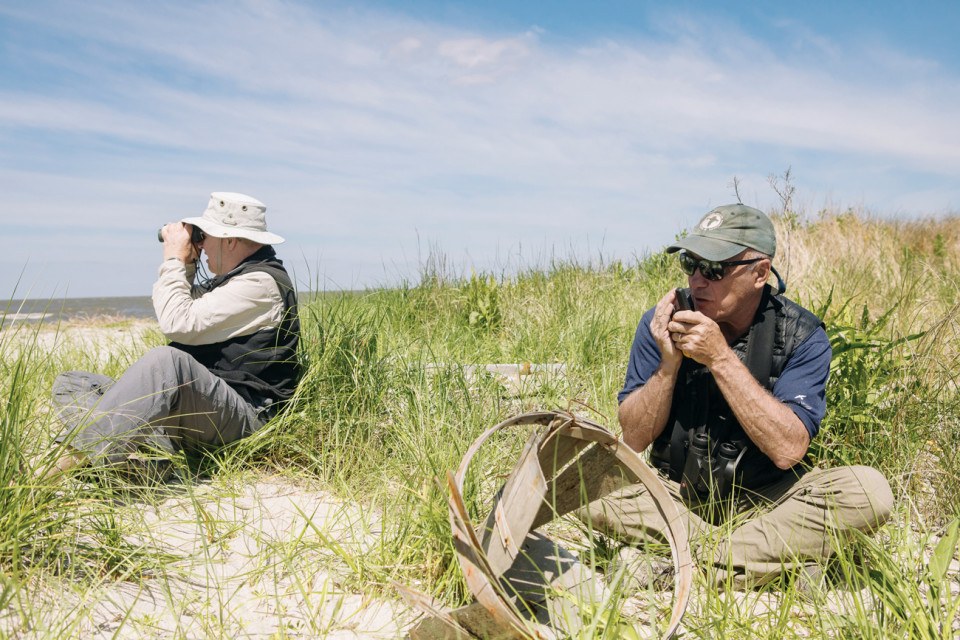
Humphrey Sitters (left) and Larry Niles wait to trap shorebirds for testing and tagging at Reeds Beach in Cape May County. / Photograph by Michelle Gustafson
In response to the nosedive, Niles, Mizrahi and many others began a full-court press to save both knots and crabs, and in 2015, the federal government declared the rufa a threatened species. New Jersey now closes its bay beaches to the public when knots are feeding.
With crabs still being caught for bait and blood, the impact of the harvest on both crabs and knots is easily the most controversial struggle within the ASMFC, which regulates 26 other fisheries, for everything from eels to bluefish.
This impact would be better understood if we knew how many crabs inhabit Delaware Bay. But key players in the tug of war have completely different estimates of how many crabs remain.
The Numbers Game
In February, a bloc of groups including New Jersey Audubon and the American Littoral Society petitioned the U.S. government to declare the horseshoe crab endangered. “We are in danger of seeing both the horseshoe crab and the red knot go extinct across their ranges,” Dillingham asserts, and criticizes the horseshoe-crab fishery as “poorly regulated.” He and more than 50 environmental groups have created the Horseshoe Crab Recovery Coalition, one of many efforts to save the crab.
But Caitlin Starks, a senior fishery coordinator who’s involved in the process of regulating horseshoe crab harvests, says that alarm is overblown. She sites a Virginia Tech trawling study performed last year that painted a much rosier picture: 40 million mature males and 16 million mature female crabs in the Delaware Bay. In other words, they’re hardly endangered. Fisheries biologists with both the New Jersey and Delaware agencies support the numbers Starks shared. Jordan Zimmerman, of Delaware’s Division of Fish & Wildlife, insists that “crab populations have grown over the last decade,” and his New Jersey counterpart, Joseph Cimino, is practically combative. “The story that crabs are endangered is more interesting than the facts,” Cimino says. “The controversy is a failure on our part that we have not communicated that the population is safe.”
To that, Niles pushes back. “The crab population just hasn’t increased,” he says. “We’ve looked at their size — a measure of maturity — and their width should be getting bigger. But it’s not; it’s getting smaller. We’ve also not seen a meaningful increase in egg density on beaches. Where once it was 50,000 eggs per square meter of beach, now it is only 5,000 or 10,000.” Fewer eggs on beaches, he says, must translate into fewer adults in the bay. Crab advocates have long lobbied for independent researchers not affiliated with government agencies to examine the trawling studies ASMFC uses, convinced those studies are missing something. ASMFC insists it’s using the best science available and consistently rejects these requests.
Mizrahi acknowledges that “there has been some modicum of improvement, but from what level? Is the population where it needs to be? No.” He sighs. “We’ve been arm-wrestling with the ASMFC for as long as I can remember.”
Cimino doesn’t want to come across as cavalier. “Given that it takes a female years to fully mature, we shouldn’t be surprised it’s been a slow turnaround,” he says. “The population may not be the size it was 40, 50 years ago, but I feel good about the direction we’re moving.”
The ASMFC meets again this month, and depending on the current bird and crab counts, sparks will likely continue flying. That the Recovery Coalition’s members are lobbying for the crab to be declared endangered only adds fuel to a long-existing fire — one turbocharged by a warming planet.
Enter Climate Change
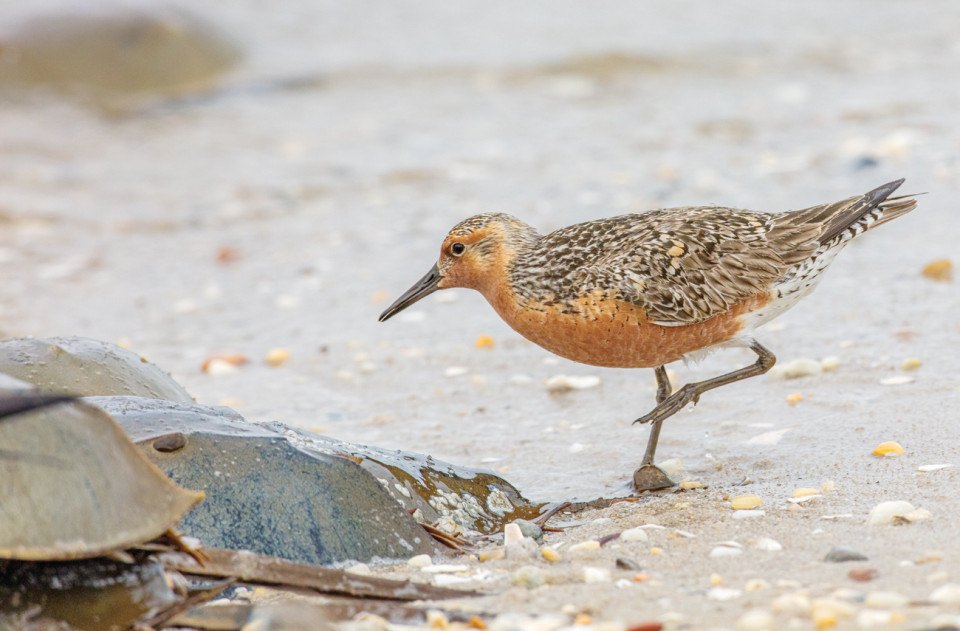
A red knot on the New Jersey side of Delaware Bay / Photograph by Doug Wechsler
As if knots and crabs don’t have enough to worry about, climate change has emerged as a new threat. In the spring of 2020, the weather stayed cool, crabs remained out in the bay, and spawning was delayed. But the knots arrived on time, and when they found no eggs, too few survived the trip north and back. A year later, Niles counted only 6,000 knots along the bay — a record low.
Biologists agree that if horseshoe crabs spawn too early or too late for too many years, the red knot’s chances for survival are slim. As Niles puts it: “If the spawning peak is pushed past when the birds are here, the birds are screwed.” Red knots have what Mizrahi calls a “give-up threshold”: If they fly onto beaches before crabs emerge, they won’t wait around for food — they’ll fly elsewhere, like to the ocean side of Cape May. “If this happens over enough years,” he says, “they’ll stop coming to Delaware Bay.”
Worse, climate change upends every phase of the knot’s life cycle. The Arctic’s climate has been changing rapidly, and this affects the knots; if their eggs hatch after the insects they need have finished emerging, the hatchlings won’t have enough food to survive the trip back south. Climate impacts migration flyways as well; as the number and intensity of Atlantic tropical storms rises, knots returning to South America during peak hurricane season could be devastated.
And it’s no surprise that climate hurts crabs, too. As sea levels rise and storms intensify, Cape May beaches are eroding, and there will soon be less spawning habitat than existed historically. Where will the crabs go then?
Weidensaul says the knots “have put all their eggs in one very risky basket.” That basket grows flimsier each day. For both sides of the debate, though, there’s a glimmer of hope on the horizon.
A Sea Change for Crabs

A horseshoe crab returns to the surf at Pierces Point. / Photograph by Doug Wechsler
Jay Bolden, a senior director at pharmaceutical giant Eli Lilly, works in his native Indianapolis, far from knots or crabs. An avid birder, he’s a leader in research on new synthetic reagents that detect toxins in medicines and supplies even better than LAL can. Recognizing that LAL “comes from a wild animal, not a farmed animal — there is a finite number of them,” Bolden has intensively studied a genetically engineered product called recombinant factor C, or rFC, that relies on proteins cloned from horseshoe-crab DNA. Given that this protein can now be reproduced in perpetuity, living crabs aren’t needed. Bolden’s team’s highly successful testing convinced Eli Lilly to begin switching over in 2018, and, today, the pharma company has converted its manufacturing sites to rFC. A full 80 percent of Eli Lilly production now uses rFC, Bolden says.
Others are joining, he offers — Sanofi, Roche Pharmaceuticals, Pfizer and Glaxo SmithKline. Charles River has patented its own recombinant reagent, and its current LAL test utilizes 95 percent less horseshoe-crab raw material than traditional testing, according to the company.
One roadblock has long been the United States Pharmacopeia, a massive compendium of best practices. Bolden sits on the USP’s committee to study recombinant synthetics, and the group is likely to agree to adopt synthetics this fall.
And Bolden is tickled to share that Eli Lilly has developed an automated system that needs little human intervention for rFC testing. “We call it Project Red Knot,” he offers, grinning. After all, rFC may save his beloved knot.
May Days
As horseshoe crabs again haul themselves onto beaches and red knots fly in from South America once more, May will be bustling along the bay. International teams of biologists will be counting and tagging red knots while conducting crab eggs counts. Anxious birdwatchers will descend on the bay to seek out precious knots, and while New Jersey’s knot-hot-spot beaches will be roped off to keep people (and pets) away from the birds, volunteers will staff the rope lines to answer questions. Groups like New Jersey Audubon, the Littoral Society, the Dupont Nature Center and many others will be offering public programs and events, hoping to pull volunteers into their research efforts. The Ecological Research & Development Group will reinvigorate its “Just Flip ’Em” program, exhorting everyone who sees an upside-down crab struggling to right itself to flip it over.
In the end, the fates of crab and knot are intimately intertwined. Horseshoe crabs lumbering up beaches this month have survived not only the asteroid that killed dinosaurs 66 million years ago, but four other mass-extinction events, too. They’re survivors: For as long as there has been a Delaware Bay, crabs have rumbled up its springtime surf, year after year after year.
Crab Traps
The best spots to catch the sex and gluttony of migration

There are many sites along the bay in both Delaware and New Jersey where you can see the horseshoe-crab phenomenon. But since knots are always on the move, there’s no guaranteed site.
On the New Jersey side, birders flock to several Cape May County sites: 1. Reeds Beach, 2. Cooks Beach, 3. Kimble Beach and 4. Pierces Point, all easily accessible off Route 47. Bring binoculars, and stay behind the temporary fencing; often, volunteers staff the beaches to share the story and tell you which beach might be best that day.
On the Delaware side, the best viewing places include 5. Port Mahon, 6. Pickering Beach, 7. Kitts Hummock and 8. Slaughter Beach. Jordan Zimmerman, of Delaware’s Division of Fish & Wildlife, suggests going to the 9. Dupont Nature Center: “They have a viewing platform where crabs are spawning inside the harbor, and they’ve got a large congregation of red knots and other shorebirds. There’s viewing equipment and knowledgeable people, too.” The state runs a “Green Eggs and Sand” program, and you can volunteer to help with spawning surveys.
Published as “Turning the Tide” in the May 2024 issue of Philadelphia magazine.
Editor’s note: This story has been updated to clarify Caitlin Starks’s role at the Atlantic States Marine Fisheries Commission and the data she shared.

